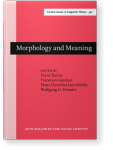Diachrony and the polysemy of derivational affixes
In this paper we discuss two cases of seemingly polysemous derivational affixes: the Ewe suffix -ví, originally a noun meaning “child”, which has acquired a number of different semantic values in word formation, as e.g. “inexperienced” (núfíáláví “inexperienced teacher”) or “person who adheres to the typical behaviour of a group” (amredzóví “someone who behaves like a foreigner”, and the Mandarin Chinese suffix -bā, originally a lexical morph meaning “bar”, which also helps to form locative nouns conveying a broad range of meanings, as e.g. in yóuxìbā (game-bā) “amusement arcade” or in yǎnbā (eye-bā), a kind of optometry clinic. We shall show that apparent polysemy may be a consequence of generalization, rather than of specialization in meaning, and that the mechanisms involved in the evolution of derivational affixes are mostly analogous to those of grammaticalisation.
References (21)
References
Apresjan, Juri D. 1974. “Regular Polysemy”. Linguistics 142.5–32.
Arcodia, Giorgio Francesco. 2011. “A Construction Morphology Account of Derivation in Mandarin Chinese”. Morphology 21.89–130. 

Aronoff, Mark. 1976. Word Formation in Generative Grammar. Cambridge, Mass.: MIT Press.
Bauer, Laurie. 2001. Morphological Productivity. Cambridge: Cambridge University Press. 

Blank, Andreas. 1997. Prinzipien des lexikalischen Bedeutungswandels am Beispiel der romanischen Sprachen. Tübingen: Max Niemeyer. 

Booij, Geert. 2010. Construction Morphology. Oxford: Oxford University Press.
Goldberg, Adele E. 1995. Constructions. A Construction Grammar Approach to Argument Structure. Chicago: University of Chicago Press.
Heine, Bernd, Ulrike Claudi & Friederike Hünnemeyer. 1991. Grammaticalization: A Conceptual Framework. Chicago: University of Chicago Press.
Hopper, Paul & Elizabeth C. Traugott 2003. Grammaticalization. 2nd edition. Cambridge: Cambridge University Press. 

Jurafsky, Daniel. 1996. “Universal Tendencies in the Semantics of the Diminutive”. Language 72:3.533–578. 

Magni, Elisabetta. 2008. “Conservazione e innovazione nella morfologia derivazionale dell’italiano: analisi sincronica e diacronica del suffissoaio”. Prospettive nello studio del lessico italiano: Atti del IX Congresso SILFI, Firenze, 14–17 giugno 2006 ed. by Emanuela Cresti, 497–506. Firenze: Firenze University Press.
Rainer, Franz. 2005a. “Semantic Change in Word Formation”. Linguistics 43:2.415–441. 

Rainer, Franz. 2005b. “Typology, Diachrony, and Universals of Semantic Change in Word-Formation: A Romanist’s Look at the Polysemy of Agent Nouns”. Morphology and Linguistic Typology.
Online Proceedings of the Mediterranean Morphology Meeting (MMM4)
,
Catania
21–23 September 2003
ed. by Geert Booij, Emiliano Guevara, Angela Ralli, Salvatore Sgroi & Sergio Scalise, 21–34. Bologna: Università di Bologna.
Luschützky, Hans Christian & Franz Rainer. 2011. “Agent Noun Polysemy in a Cross-Linguistic Perspective”. STUF—Language Typology and Universals 64:4.287–338. 

Rongier, Jacques. 2004. Parlons Éwé. Paris: L’Harmattan.
Scalise, Sergio & Antonietta Bisetto. 2008. La struttura delle parole. Bologna: Il Mulino.
Scalise, Sergio, Antonietta Bisetto & Emiliano Guevara. 2005. “Selection in Compounding and Derivation”. Morphology and its Demarcations ed. by Wolfgang Dressler, Dieter Kastovsky, Oskar E. Pfeiffer & Franz Rainer, with the assistance of Francesco Gardani and Markus A. Pöchtrager, 133–150. Amsterdam & Philadelphia: John Benjamins.

XH 2003 = ??????? [The Xinhua Dictionary of New Words]. Beijing: The Commercial Press.
Cited by (1)
Cited by one other publication
Janda, Laura A.
2023.
Polysemy of Affixes. In
The Wiley Blackwell Companion to Morphology,
► pp. 1 ff.

This list is based on CrossRef data as of 24 july 2024. Please note that it may not be complete. Sources presented here have been supplied by the respective publishers.
Any errors therein should be reported to them.
